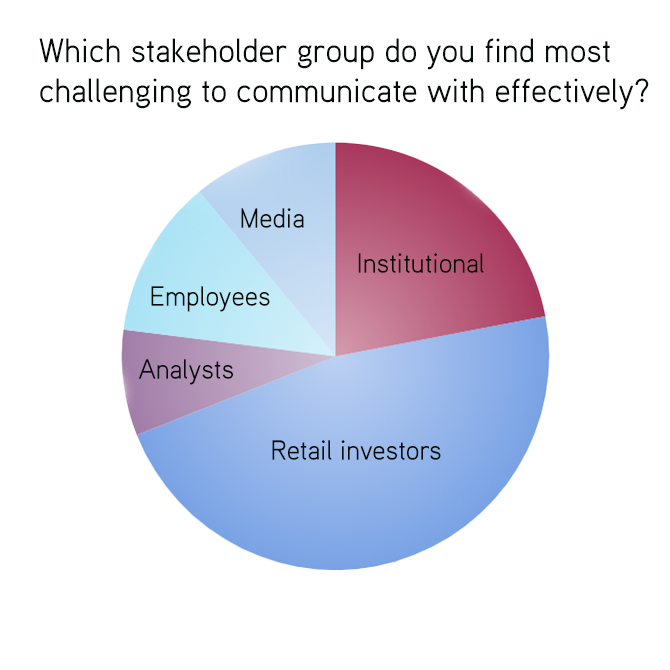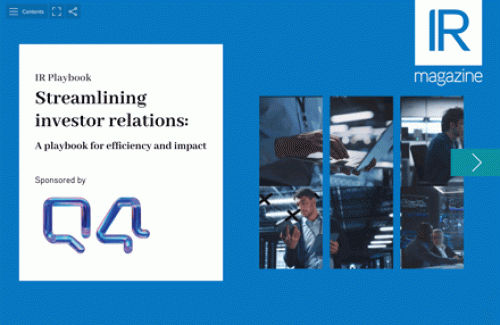IR officers face more than one hurdle when communicating with members of the investment community, from establishing trust and fostering credibility to adapting to audiences with different levels of financial literacy.
The latest IR Magazine Webinar, in partnership with Notified, looked at some of the best practices for achieving IR communications that are tailored, targeted and trustworthy, and examined the role AI can play in this regard.
Click here to watch a replay of the webinar.
Below are five key takeaways from the webinar. Panel experts included Erik Carlson, chief operating officer at Notified, Ally DeVoe, senior IR manager at Boston Scientific Corporation and Nilay Shah, executive vice president and head of IR at Lionsgate.
Think about hyper-personalizing your message
At the start of the webinar, speakers and attendees alike were asked to point out which stakeholder group they find most challenging to communicate with effectively.
‘I would say the employees at my own company,’ said Shah. ‘I think a lot of times employees see the stock move, they see [press releases] and headlines [but] they may not have the experience to understand the implications of these changes even if [working at a public company] they are granted shares every year as part of their compensation.
‘So I have to figure out a way to explain as much as I can, without giving any non-public information, and walk them through what is going on with the company and industry.’
DeVoe agreed, saying the challenge with employees is that they can hear ‘a tale of two stories’.
‘[Sometimes] we’re saying results are looking really strong but internally there are still financial measures in place to ensure we’re achieving the goals that mean our financials are really strong,’ she explained. ‘One of the things our team tries to do is help employees understand why there are differences and why achieving our financial goals externally is so important to us.’
Answering the poll question, 45 percent of webinar attendees said they find retail investors the most difficult segment of their shareholder base to communicate with.

‘We talk about having the context, the ability to interpret messages and to be more sophisticated in interpreting what you’re ultimately communicating externally, [but that’s] not always the case with the retail investor audience,’ noted Carlson.
‘When talking to some IROs, [they often say] the juice is not always worth the squeeze: you can spend an enormous amount of your time customizing messaging to individual retail investors when the reality is, unless you can come up with an approach that’s really effective and efficient across that base – especially for real estate investment trusts, which tend to have a heavy retail investor base – it [won’t move] the needle as much.’
For Carlson, it is all about hyper-personalization and the ability to take the core message and then purpose-build it for a specific audience segment.
Adapt but stay consistent
While the way in which companies deliver the message may vary depending on the audience, the story that reaches the street should remain consistent.
‘Making sure the [company] message resonates with the external world and each type of consumer is the goal of the IR team,’ said DeVoe. ‘But the important part to me is that the core message remains the same. Your strategy, your key takeaways for the quarter [and] earnings [communications] should be consistent, no matter who you’re talking to.
‘And then it’s how you kind of elaborate on that to make sure you’re hitting on the things you know will be most important to the stakeholder you’re talking to.’
Consider geographical differences
According to Carlson, achieving consistency in the communications strategy will provide the foundation for creative and targeted messaging that will resonate with specific audiences depending on geography and even demographics.
For instance, European investors have been traditionally more focused on ESG regulations than have US ones, so to talk about ESG-related frameworks or policies may resonate better with shareholders in Europe.
Effective communication is a two-way process, Carlson said, arguing that it’s important to understand what motivates the recipient. ‘I would advise IROs to work really closely with their PR and corporate comms department,’ he suggested.
‘Make sure that when you have a message for the Street you’re building a messaging or communication matrix document and working with your public relations partner to really tailor it for internal town halls [and external recipients].’
Invest in trust
It’s no secret that building trust with stakeholders is the first pillar of effective communications. But with the wider use of sophisticated AI tools and the subsequent amount of information generation, trusting every piece of content on the internet is not necessarily safe. In fact, Carlson said, one of the macro themes and challenges for issuers and corporates is linked to the fact that AI is amplifying distrust.
‘Typically, people come in with the default of questioning whether something is real, versus assuming that it’s real if it’s a corporate news story,’ he explained. ‘So while it’s good to employ cynicism, I think one of the biggest challenges with issuers and corporate communications – not just on the IR side, but [also] on the PR side – is validity and fidelity of messaging and how you build a brand narrative around trust.’
To do that, it’s important to find the right partners, he added: ‘Great companies that are [building a narrative around trust] are investing in trust, whether that’s partnering with organizations that are verifying the types of news they’re releasing, or just making sure there’s consistency in their messaging from quarter to quarter and demonstrating the ability to execute on that strategy or that consistency.’
Can AI help with your communications?
A second poll during the webinar asked panelists and attendees to what extent they would like to use AI, automation or other technology to improve and increase the efficiency of their IR communications. Nearly six in 10 respondents said they would want to leverage tools like AI or similar for this purpose.

‘I wholeheartedly agree that AI presents significant opportunities for efficiency and automation, [but] it’s how you [integrate these technologies] while running as fast as you can supporting the business and managing your day-to-day responsibilities,’ said DeVoe.
‘One of the things that’s been really important to us at Boston Scientific is ensuring we are not using AI in silos. We have tried to take an enterprise approach to the use of AI.’
Her firm, she explained, is exploring AI through internal pilots and will eventually start using it for marketing and sales. As for IR, she says for her it’s important to ensure that the level of relationship with investors and analysts and Boston Scientifics’ small retail investor base stays personal.
For a small company like Lionsgate, AI is a powerful tool for optimizing the use of resources, especially in terms of revenue generating and content production, noted Shah. But when it comes to IR specifically, the use of AI at his firm is still quite limited.
‘While I strongly agree that we’d like to use AI and automation, the company itself is not devoting a lot of capital to the C-suite and IR to help us adopt those [tools],’ he said. ‘I can use free tools like ChatGPT to summarize things or improve messaging [and] I agree it’s going to be a big driver. I just don’t think that from a resource standpoint, we are going to be writing big checks.’
‘I would say the industry is still nascent and we’re not there yet with the fidelity of information we’re getting [and] the quality of that information,’ added Carlson. ‘So I tell employees and clients all the time to experiment with the technology, understand the limitations and use it for what it’s good at right now – which is ideation – and then take kind of verbiage or qualitative statements and tailor those [to audiences].’










